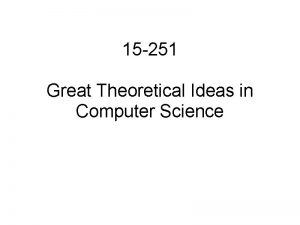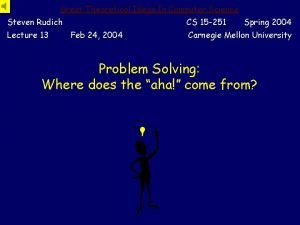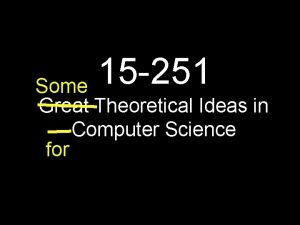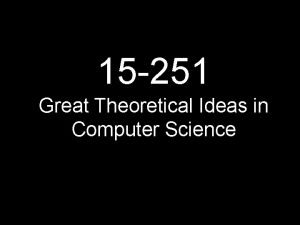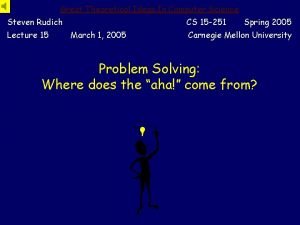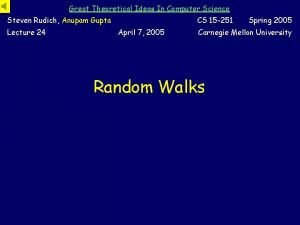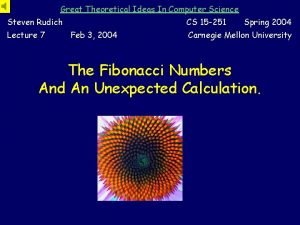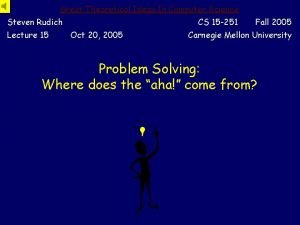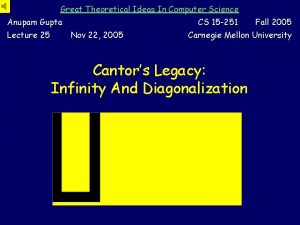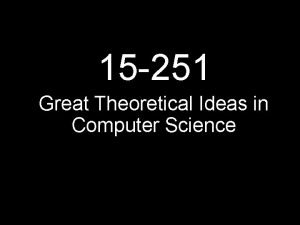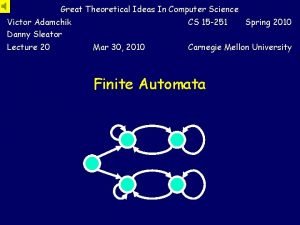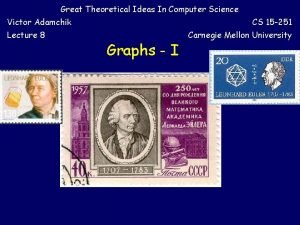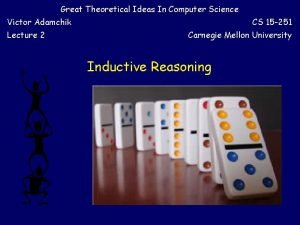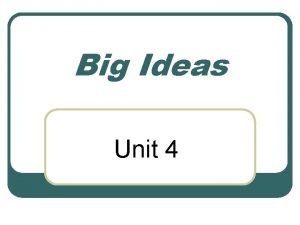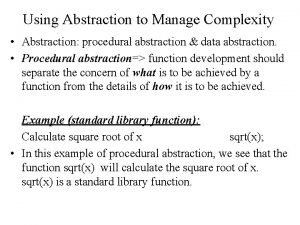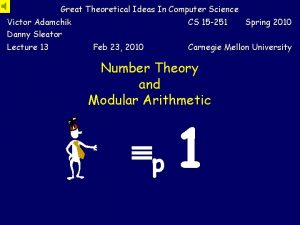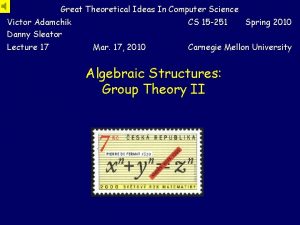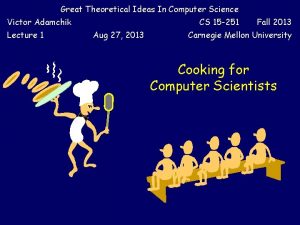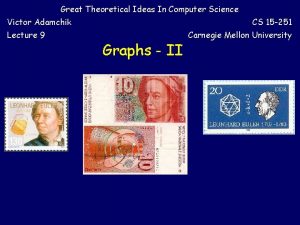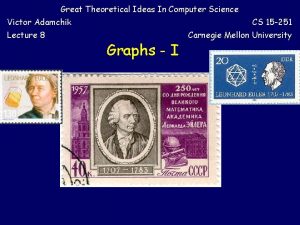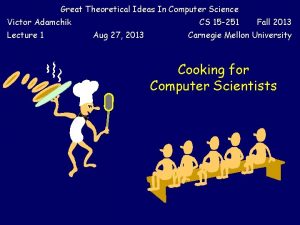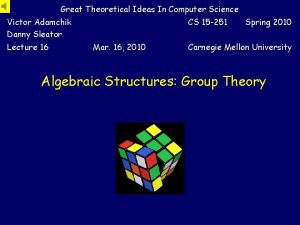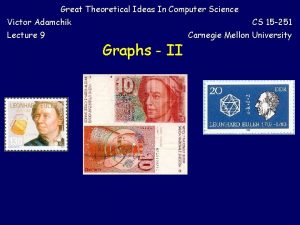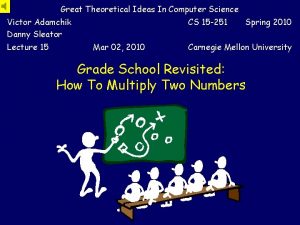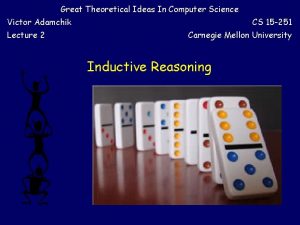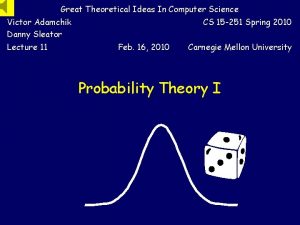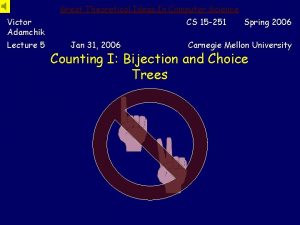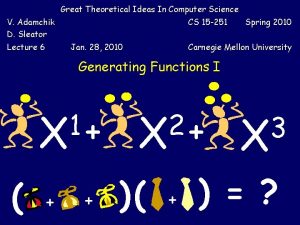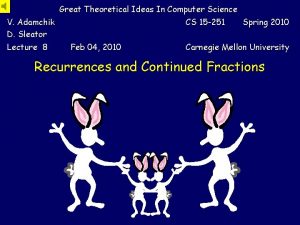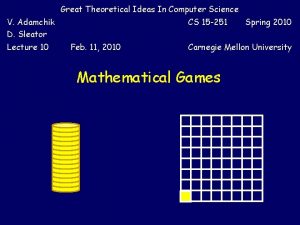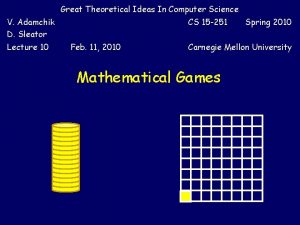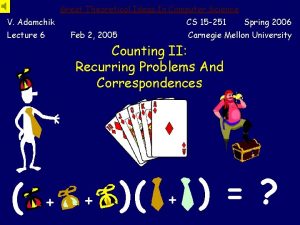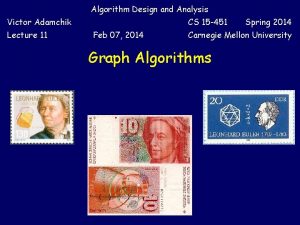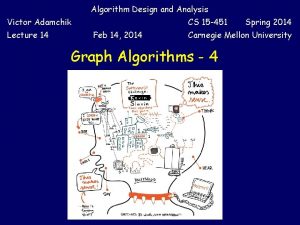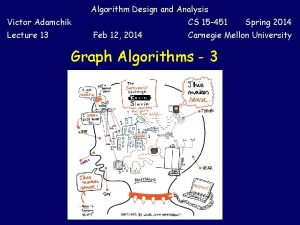Great Theoretical Ideas In Computer Science Victor Adamchik























































- Slides: 55

Great Theoretical Ideas In Computer Science Victor Adamchik Lecture 2 CS 15 -251 Carnegie Mellon University Inductive Reasoning

Raise your hand if you NEVER heard of mathematical induction

Mathematical Induction Standard Form Strong Form Least Element Principal Invariant Form Structural Induction

American Banks in 2008 Domino Effect: Line up any number of dominos in a row; knock the first one over and they will all fall

Dominoes Numbered 1 to n Dk : “The kth domino falls” If we set them up in a row then each one is set up to knock over the next. Here are the rules: 1. D 1 2. Dk Dk+1 (if kth falls, then (k+1)st falls) D 1 D 2 D 3 … All Dominoes Fall

Proof by Mathematical Induction In formal notation. Let P(k) be a statement [P(0) , k (P(k) P(k+1) )] n P(n) Instead of attacking a problem directly, we only explain how to get a proof for P(k+1) out of a proof for P(k)

Plain Induction Suppose we have some statement P(n) that holds for some natural numbers n. To demonstrate that P(n) is true for all n is a little problematic.

Inductive Proofs Base step(s): Show that P(0) holds Induction Hypothesis: Assume that P(k) holds Induction Step: Show that P(k) implies P(k+1)

Example Prove that 2 n < n! for n ≥ 4. Base step: n =4, 24=16 < 4! =24 IH: assume 2 k < k! Prove it for k+1 2 k+1 = 2· 2 k < 2×k! < (k+1)!

A Template for Induction Proofs State that the proof uses induction. If there are several variables, indicate which variable serves as k. Define a statement P(k), aka IH Prove initial case(s). Prove that P(k) implies P(k+1), aka IS State the induction principle allows you to conclude that P(n) is true for all nonnegative n.

Upper bound for Pn T(n) = 2 + T(n-1) T(2) = 1 Induction is helpful for proving the correctness of a statement, but not helpful for discovering it. Prove T(n) = 2·n-3

Upper bound for Pn Prove T(n) = 2·n-3 T(n) = 2 + T(n-1) T(2) = 1 Base step: n =2, T(2) = 2· 2 -3 = 1 IH: assume T(k) = 2·k-3 Prove it for k+1 T(k+1) = 2 + T(k) = 2 + 2·k-3 = 2·(k+1)-3

Funny Example Any group of people are all of the same gender Prove this by induction

Any group of k people are all of the same gender Base step: When k = 1, one person can certainly only be one gender. IH: Suppose the claim holds for k people Inductive step: given a set of k+1 people. Consider the subset formed by removing a person. WLOG, let it be (k+1)st.

Any group of k people are all of the same gender The remaining 1…k people are of the same gender (let say girls), by IH In particular, #2 is a girl. Also, by IH, from 2 to (k+1) are girls Therefore, all students are girls P(1) P(2)

Soundness of Induction How do we know that INDUCTION really works?

Soundness of Induction Proof by contradiction Assume that for statement P(n), we can establish the base step P(0), and the induction step, but nonetheless it is not true that P(n) holds for all n. So, for some values of n, P(n) is false. [P(0) , k (P(k) P(k+1) )] n P(n)

Soundness of Induction Let n 0 be the least such n that P(n 0) is false. Certainly, n 0 cannot be 0. Thus, it must be n 0 = n 1+1, where n 1 < n 0. Now, by our choice of n 0, this means that P(n 1) holds. because of IH, since n 1 < n 0

Soundness of Induction But then by Induction Step, P(n 1+1) also holds. Which is the same as P(n 0), and we have a contradiction.

Review that proof

We can pick n 0 to be the least n where P(n) fails.

Least Element Principle Every non-empty subset of the natural numbers must contain a least element.

Theorem Every natural number > 1 can be factored into primes

Theorem. Every natural number > 1 can be factored into primes Base case: 2 is prime Inductive Hypothesis: n can be factored into primes How do we prove it for n+1 ?

A different approach: Assume 2, 3, …, n all can be factored into primes Then show that n+1 can be factored into primes With respect to dominoes, we assume that (k+1)st falls because ALL previous dominoes fall.

Strong Induction Establish Base Case: P(0) Assume k ≤ n, P(k) is true Derive P(n+1) [P(0) , (P(0), P(1), …, P(k) P(k+1))] n P(n)

Theorem. Every natural number > 1 can be factored into primes Base case: 2 is prime Inductive hypothesis: k ≤ n can be factored into primes Case 1: n+1 is prime Case 2: n+1 is composite, n+1 = p q p, q > 1

Strong Induction How to justify the proof by strong induction? The proof is by contradiction.

Strong vs Weak These two forms of induction are equivalent. The conversion from weak to strong form is trivial From strong in P to weak: Let Q(n) : P(0) o P(1) o. . . o P(n) Base Step: Q(0) = P(0) Inductive Step: Q(n) P(n+1) Q(n) o P(n+1) Q(n) Q(n+1) Therefore, the strong induction in P can be written as a weak induction in Q

ATM Machine Suppose an ATM machine has only seven dollar and ten dollar bills. You can type in the amount you want, and it will figure out how to divide things up into the proper number of 7's and 10's. Claim: The ATM can generate any output amount n ≥ 54.

ATM Machine: Proof Base case: 54 = 2· 7 + 4· 10 Induction step: assume k = 7·a + 10·b, for all k = 54, …, n How do we proceed for k=n+1 dollars?

ATM Machine: Proof n + 1 = n − 6 + 7, n ≥ 54 By IH: n − 6 = 7·a + 10·b Hmm…, n − 6 could be less than 54. . . Therefore, we have to extend the base cases to 55, 56, 57, 58 and 59

ATM Machine: Proof Base cases: 54 = 2· 7 + 4· 10 55 = 5· 7 + 2· 10 56 = 8· 7 57 = 1· 7 + 5· 10 58 = 4· 7 + 3· 10 59 = 7· 7 + 1· 10 Induction step: assume k = 7·a + 10·b, for k = 54, …, n

ATM Machine: Proof n + 1 = (n − 6) + 7, n ≥ 60 By IH: (n − 6) = 7·a + 10·b n + 1 = 7·a + 10·b + 7 = 7·(a+1) + 10·b Therefore any number ≥ 54 can be formed using 7 and 10 bills

Faulty Induction Claim. 251*n = 0 for all n>=0. Base step: Clearly 251*0 = 0. IH: Assume that 251*k=0 for all 0<=k<=n. We need to show that 251*(n+1) is 0. Write n+1=a+b. , where a, b > 0. 251*(n+1) = 251*(a+b) = 251*a + 251*b =0+0 = 0

Chocolate Bar Given a chocolate bar made up of n by k squares. At each step, you choose a piece of chocolate and snap it in two along any line, vertical or horizontal. Show by induction that the number of snaps required to reduce it to single squares is n k - 1.

Chocolate Bar Claim. It requires nk-1 snaps Note, there are two variables n and k. We prove it by strong induction on the number of squares s = n k. If s = 1, no breaks are required and n k-1 = s -1 = 1 -1 = 0

Chocolate Bar Claim. It requires s-1 snaps IH: assume that this is true for s < n Consider a chocolate bar with s = n total pieces. After the first snap, there will be two smaller bars with k 1 and n-k 1 pieces.

Chocolate Bar Claim. It requires s-1 snaps After the first snap, there will be two smaller bars with k 1 and n-k 1 pieces. By IH, it requires k 1 -1 and n-k 1 -1 breaks. Totally, (k 1 -1)+(n-k 1 -1)+1= n-1

And there are more ways to do inductive proofs

Yet another way of packaging inductive reasoning is to define “invariants” In Programming. A rule that applies throughout the life of a data structure or procedure or loop. Each change to the data structure or loop maintains the correctness of the invariant

15 -122 again … Loop invariants int fast_exp (int x, int y) //@requires y > 0; //@ensures result == pow(x, y); { int r = 1; int b = x; int e = y; while (e > 1) //@loop_invariant r * pow(b, e) == pow(x, y); { if (e % 2 == 1) r = b * r; b = b * b; e = e / 2; } return r * b;

15 -122 again … Data structure invariants: BST, Heaps, AVL Trees h-1 h-2

Inductive reasoning is the high level idea “Standard” Induction “Strong” Induction “Least Element Principal” “Invariants” are all just different packaging

Inductive Definition A linked list is either empty list or a node followed by a linked list A binary tree is either empty tree or a node containing left and right binary trees. F(0) = 0, F(1) = 1 F(n) = F(n-1) + F(n-2) recursive function

Fractals are geometric objects that are self-similar, i. e. composed of infinitely many pieces, all of which look the same.

The Koch Curve Alphabet: { F, +, - } Rules: Rule(F) = F+F--F+F Rule(+) = + Rule(-) = Rule(w 1 …wn) = Rule(w 1) … Rule(wn) Rule (F): F+F--F+F Rule(Rule (F)): F+F--F+F+F+F--F+F--F+F+F+F--F+F

The Koch Curve F+F--F+F Visual representation: F draw forward one unit + turn 60 degree left turn 60 degrees right

The Koch Curve F+F--F+F+F+F--F+F--F+F+F+F--F+F Visual representation: F draw forward one unit + turn 60 degree left turn 60 degrees right

The Koch Curve a non-differentiable curve

Structural Induction We can prove certain properties of inductively-defined sets and types (in ML, for example) Structural Induction uses the same steps as regular induction. 1. Prove the base cases of the definition. 2. Prove the result of any recursive combination rule, assuming that it is true for all the parts

Recursively Defined Sets Consider a set S defined by Base Step: 3 S Recursive Step: if x S and y S , then x+y S What does S contain?

Structural Induction 1. Base Step: 3 S 2. if x S and y S , then x+y S We will prove by induction that the set S contains number divisible by 3. Base step: 3 | 3. Inductive step: Assume, 3|x and 3|y, then x = 3 a, y = 3 b z=x+y =3 a+3 b=3(a+b) =3 c, where c=a+b, thus 3|z.

Structural Induction Theorem. For any non-empty binary tree T = (V; E), |V| = |E|+ 1. Base step: T is a single root node: |V|=1, |E|=0 Induction step: Assume T contains TL and may contain TR, for which the claim is true: |VL|=|EL|+1, |VR|=|ER|+1, If TR is empty: |V| = |VL|+1 = |EL|+1+1 = |E|+1, If TR is nonempty: |V| = |VL|+|VR|+1 = |V L|+|VR|+3 = |E|+1,

Inductive Proofs: Study Bee Standard Form Strong Form Least Element Principal Invariant Form Structural Induction
 Great theoretical ideas in computer science
Great theoretical ideas in computer science Great ideas in theoretical computer science
Great ideas in theoretical computer science Great theoretical ideas in computer science
Great theoretical ideas in computer science Great theoretical ideas in computer science
Great theoretical ideas in computer science Great theoretical ideas in computer science
Great theoretical ideas in computer science Great theoretical ideas in computer science
Great theoretical ideas in computer science Great theoretical ideas in computer science
Great theoretical ideas in computer science Great theoretical ideas in computer science
Great theoretical ideas in computer science Great theoretical ideas in computer science
Great theoretical ideas in computer science Great theoretical ideas in computer science
Great theoretical ideas in computer science Victor adamchik
Victor adamchik Victor adamchik
Victor adamchik Victor adamchik
Victor adamchik Snapsih
Snapsih Cse 111
Cse 111 Cs graph theory
Cs graph theory Eight ideas in computer architecture
Eight ideas in computer architecture Task level parallelism
Task level parallelism Cs61c
Cs61c 8 great ideas in computer architecture
8 great ideas in computer architecture Eric’s favourite .......... is science
Eric’s favourite .......... is science Ideas have consequences bad ideas have victims
Ideas have consequences bad ideas have victims Que es una idea principal
Que es una idea principal China big idea
China big idea Science national honor society project ideas
Science national honor society project ideas National children's science congress projects ideas
National children's science congress projects ideas Turning great strategy into great performance
Turning great strategy into great performance South dakota state animal
South dakota state animal With great power comes great responsibility voltaire
With great power comes great responsibility voltaire Hammerhead vs great white shark
Hammerhead vs great white shark Does alexander the great deserve his title
Does alexander the great deserve his title Frederick the great education
Frederick the great education With great expectations comes great responsibility
With great expectations comes great responsibility A great deal vs a great many
A great deal vs a great many With great power comes great responsibility batman
With great power comes great responsibility batman Does alexander deserve to be called the great
Does alexander deserve to be called the great No shadow of turning
No shadow of turning Great explorations in math and science
Great explorations in math and science Social science vs natural science
Social science vs natural science Branches of biology
Branches of biology Natural and physical science
Natural and physical science Applied science vs pure science
Applied science vs pure science Rapid change
Rapid change Science fusion introduction to science and technology
Science fusion introduction to science and technology Why environmental science is an interdisciplinary science
Why environmental science is an interdisciplinary science Windcube lidar
Windcube lidar Hard science and soft science
Hard science and soft science Wjec gcse computer science
Wjec gcse computer science University of phoenix computer science
University of phoenix computer science How many fields in computer science
How many fields in computer science Example of procedural abstraction
Example of procedural abstraction Unsolved computer problems
Unsolved computer problems Bridgeport engineering department
Bridgeport engineering department Bridgeport engineering department
Bridgeport engineering department Apcsp sequencing
Apcsp sequencing Ucl cs
Ucl cs
